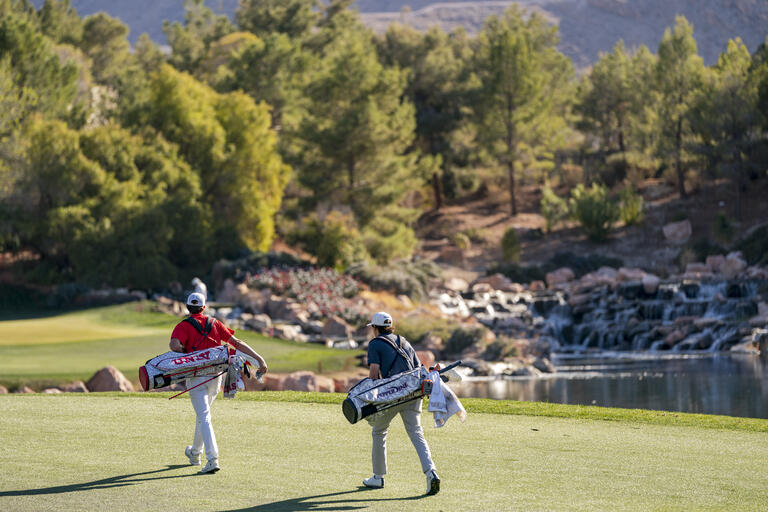UNLV senior Lee M. Hanover has big plans for the future -- most of which, oddly enough, hinge on the past. A passionate historian in the making, Hanover was one of four recipients of this year's UNLV University Libraries Lance and Elena Calvert Undergraduate Research Award, an endowed award that recognizes excellence in research and critical thinking across all fields of study.
Hanover's research project, "New York Oneida: Land Claims, Federal Policies, State Intervention, and Casino Development," explores the prosperity experienced by this Native American group as a result of its innovative use of sovereignty rights. It also provided the perfect opportunity for him to demonstrate the remarkable research strategies and skillful use of resources that ultimately earned him a Calvert.
Research projects can be a bit like Alice going down the rabbit hole. Tell me about how you started researching and where it took you, literally and figuratively.
My faculty mentor, Dr. William Bauer (of the UNLV history department), had us go into the Libraries' Special Collections the first week of class and work with the Katherine Spilde Collection, which is exhaustive. You find yourself wanting to include everything in there in your work, but you can't. That's a large part of research and working with collections in general: You have to get really deep into it before something manageable sparks. Lucky for me, I did find a thesis statement I could work with. That came about through my grappling with this collection.
What was the most surprising thing you learned from that experience?
There are 40-something boxes in the Spilde Collection. I mean, the sheer size of it can be intimidating. While reading a draft of my reflective essay, Dr. Mary Wammack (in the history department) picked up on my initial sense of trepidation in the face of this massive collection and encouraged me to refocus my thoughts and commentary on all I was learning from interacting with the archive instead. When you first start research in a collection like that, it can be daunting, and you might want to scream and throw boxes, but eventually you come up with an idea that is original, that is your own.
What do you think you would you have done if you weren't able to find that idea in those boxes?
I don't think it would've been insurmountably difficult because the Libraries has so many resources and collections, and they make it easy to access them and integrate them into papers. The Libraries has these amazing databases and search engines, so I'm sure something would've popped up.
What role did UNLV faculty play in helping you create your Calvert Award-winning project?
Dr. Bauer was there along every step of the research process. He pushed our class in the direction of the Spilde Collection. If I hadn't had that direction, my research would've been a lot more scattered.
During a class session in Special Collections, Su Kim Chung (head of public services in the department) introduced us to the Spilde Collection, advised us on how to request boxes, and provided an overview of the Spilde Collection's online guide. She gave us a helpful perspective on the issues and benefits of archival research.
The Calvert Award workshop helped me understand what good reflective essays and bibliographies look like. Libraries faculty members (Melissa Bowles-Terry and Kate Wintrol) provided examples of both strong and weak reflective essays submitted years prior. As students gave their insights into the issues and successes of those essays -- a type of peer critique -- I realized what the goals of a successful reflective essay are.
Dr. Bauer was also integral to the development of my reflective essay and the overall Calvert Award application process. He helped me structure my ideas and arguments and then sponsored me for the award. I'm really humbled by having a professor back up my work like he did. A large part of this award and project is due to him.
Any plans to expand this project or dive into a new one in the near future?
Prior research always contributes to future research. The paper I did for Dr. Wammack's History 251 class was on Native Americans in the American Revolution, and that introduced me to Oneida sovereignty, which was my subject for this one. I'm applying to graduate school in the summer and would like to continue working with the UNLV history department faculty, as they've been integral to my successes, and see where my studies take me, because I'm interested in everything. I just love history for what it is.
And now, the $64,000 question: Did you have fun?
Oh, yeah! It's fun working with these abstract thoughts or even solidifying them with information and statistics, then turning them into general histories that someone else down the line can read and say, "Look how this relates to my own work, my own life, or this community."
I mean, I didn't even scratch the surface of the Spilde Collection, and that collection alone could lead to so many studies, dissertations, or just background information into other people's works. The Libraries' resources are there at my disposal to provide me with material for papers or books I could actually get published, and that's ultimately what I would like to do: work with a university, do my own research, and get published. This project helped me realize I can actually do it.



